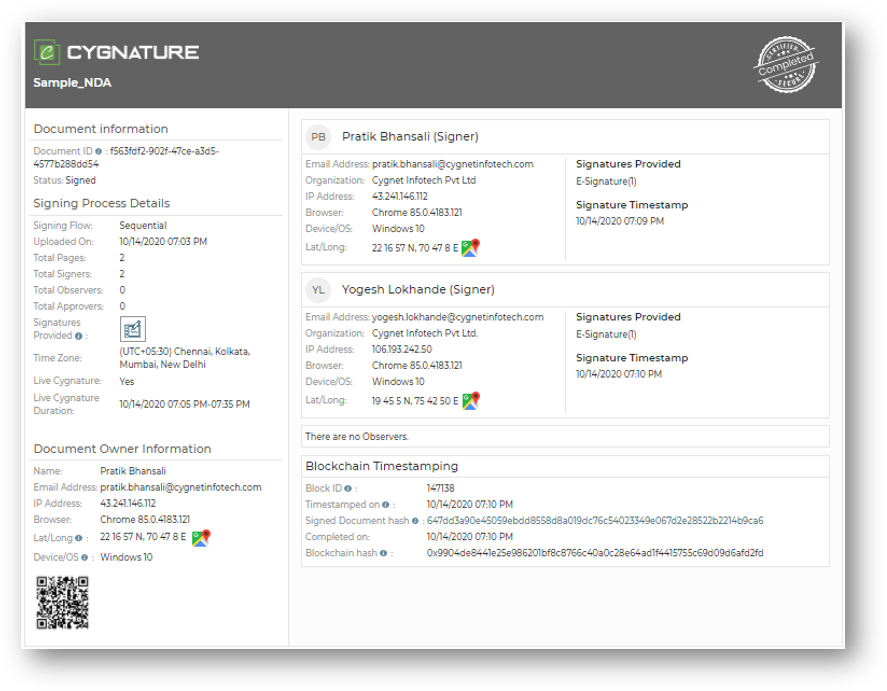Technology has transformed the lifestyle by simplifying day to day activities. Gone are the days when a person had to pay for every phone call or wait for months to receive letters from their loved ones.
On the other hand, businesses can never forget the days when the officials signed checks, authorize paper contracts, validated and verified financial transactions through traditional methods of signatures. The deadlines they required to meet put immense pressure on the employees undoubtedly. This eventually led to expensive errors.
With time, the businesses had to face bottlenecks to manage the signing activities of volumes of paper documents. This led to the rise of signature frauds.
Identify Signature Forgery
Wikipedia describes the signature forgery as an act of falsely replicating the signature of another person. There are several methods that can be used to accomplish this fraudulent activity which is mentioned below.
Random forgery- When the forger imitates a signature that has no similarity with the genuine one. It is performed without accessing the original one.
Unskilled forgery- Without any experience and knowledge of spelling, the forger traces the signature over a sheet of paper which is further used as a guide.
Skilled forgery- As the name suggests, the perpetrator practices the signatures with access to the samples of genuine signatures. The authentication of such signatures is difficult to gauge.
To get rid of these forgeries, Digitalization has played a major role. The documents are scanned and sent to the responsible officials or vendors via multiple sources such as emails for signatures. But the question is- Is going digital safe for the companies?
A report claims the cumulative loss from digital frauds cost over $93 million in 2020.
Tampering Digital Documents Is A Piece Of Cake
Among the most talked-about cases of corporate email hacking, cybercriminals hacked the ONGC ‘s official email address and successfully convinced a South Arabian client for payments in their bank accounts, costing the public sector firm Rs 197 crore.
Just like ONGC, there are many other firms who are facing the same challenges. In such cases it is certainly not difficult for hackers to tamper the digital documents such as contracts without any trace, leading to major security breaches and financial loss. And if the firm does not have any legal backup to prove the tempering in the court, it will be difficult to find justice.
Safeguard Your Business With E-signatures
According to a recent report, the e-Signature global market will reach $9.07 billion by 2023.
Investing in an e-signing solution that supports electronic, digital, and biometric signatures offers 360-degree protection to digital documents. It is incorporated with the following features enabling fraud protection and ultimate user experience.
Blockchain Is The Future
Blockchain-a distributed ledger technology offers a highly secure way to organize, store and manage documents with the features of decentralization and cryptographic hashing.
Nowadays businesses are adopting signing solution powered with the capabilities of blockchain such as-
- Trace operations with zero efforts- Blockchain allows seamless tracking and tracing of the signatures during the document process.
- Security against frauds- It offers high-level solutions to the users by preventing tampering of the records. Every single operation is recorded with the help of blockchain.
- Optimize global operations- It enables businesses to sign documents sitting anywhere in the world. Creating, editing, uploading, sending, and signing smart contracts are performed with ease.
Highly Flexible Solution
This digital age is experiencing a growing number of devices to conduct the businesses daily. Therefore, the demand for the signing solution that is compatible with multiple operating system and devices is on the rise.
Solutions like Cygnature ensures the corporate world that the signing solution can be easily utilized even on the go. Upload documents of various file types from various platforms, set advanced options when sending documents for signing like reminders, due date, etc., create groups for bulk signing, and do so much more with it. This definitely enables better client relationships and easy to use document management experience.
Irrefutable Signing Certificate
The modern digital signature tool presents irrefutable signing evidence to the parties as it authenticates the signing details by capturing timestamps, device ID, IP address browser, and signer’s location coordinates among others. Tools with Blockchain capabilities help in storing Document Hash, Transaction Hash & Document ID preventing the breaching of the documents. The process ends with the generation of a certificate of signing as the proof of signing the document.
This encourages digital integrity and data security with the condition that the digitally signed documents cannot be altered or edited after the signing is performed. Hence, it reduces the risk of the forgery of the documents.

Enhances Operational Efficiency
The digital age inspires businesses to adopt automation and streamline the document workflow with the e-signing solution. It reduces the tedious administrative tasks & eliminates human error, diminishes costs on resource supplies like paper, and ensures the signers with highly advanced digital authentication. This results in an increase in employee productivity and work efficiency
Conclusion
With the standard methods of document verification, advanced ways to prove the signer’s identity, and blockchain & automation powered e-signing solution, the documents get the necessary protection they deserve.
If you are planning on investing in the perfect e-signing solution that comes with all the above-mentioned capabilities to protect not only your business but also your clients from signature frauds and data tempering, Cygnature is the trusted digital signing solution. Contact today: hello@cygnature.io